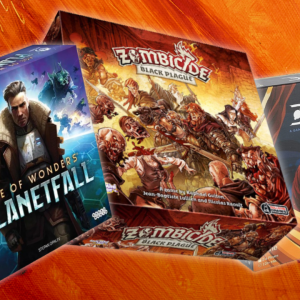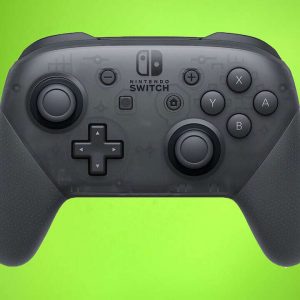[ad_1]
The Dead Cells board game isn’t the first tabletop title to be inspired by a video game, nor is it the first to try and mimic the feel of a rogue-like game. There’s even one – Sanctum – which is so clearly indebted to the Diablo franchise that it makes you wonder they weren’t served with a copyright infringement. But it does look to be the first official adaptation of a rogue-like and it’s an interesting choice. The Dead Cells video game won plaudits for its fast, demanding combat which isn’t something a board game can easily replicate. So the designers – including Antoine Bauza of 7 Wonders fame – will have had to look for something else to focus on.
See Dead Cells: The Rogue-Lite Board Game on Kickstarter.
What’s in the Box
We played a prototype of the Dead Cells board game which wasn’t complete, but it contained everything needed to play through the first two levels and a boss. Each level has its own board and tuckbox of goodies, which includes tiles to place on the board, two decks of monster cards – regular and elite – and smallers decks for treasure and blueprints. The boss has a reference sheet and a deck of cards.
There are also several boards used to track game state. One is for combat, another, the annexe board, for treasure and the third is the interbiome board where players can purchase upgrades between biomes. This is notable for having sleeves actually affixed to the board so it’s easy to store your upgrades between games. There’s a variety of tokens to track things like health and loot such as cells and gold teeth earned during your run.
Each player gets a Beheaded board which features unique upgrade paths for the three game stats, brutality, tactics and survival. They also get a deck of combat cards. Players move as a group so there’s only a single miniature in the game to track their progress on the board, an impressive tableux of Beheaded. It’s worth noting that the player board and cards feature some pretty impressive cartoon-style art of the Beheaded characters in action.
Rules and How it Plays
Again, this being a prototype, the rules are subject to change. But as it stands this is a fast-playing cooperative game where the group has to work together to get through as many biomes as possible. Players make a collaborative decision over where to move the figure through branching paths on the biome board, encountering treasure, monsters, merchants and other features represented by shaped, face-down tiles. Some paths require the group to have access to particular runes before they can be traversed.
Reaching a consensus on group decisions in cooperative games can be awkward and the genre as a whole is plagued by a problem known as quarterbacking, where the group is inclined to let itself be bossed around by the most experienced, or perhaps the loudest, player. To combat this, Dead Cells gives one player the First Player crown and they get to be the final arbiter of all decisions. The crown is rotated at intervals by an icon you can flip on some tiles. The First Player also gets to be the recipient of particular treasures and can be a damage magnet in monster encounters.
Combat features another innovation to keep cooperative play interesting. It takes place over three rounds. Monster cards are placed in different slots around the players and each features three action bars indicating what the monster will do on that round. Mostly this is straight up damage, but they can also do things like shield other monsters or inflict conditions like poison or bleed on players. Player combat cards feature the same, three bars with different actions but in addition to the monster combat icons they can also use equipment or loot, which is the only way to pick up loot promised by the encounter tile. But here’s the kicker: players select their combat cards independently and they can only discuss one of the three actions on the card.
This gives what would otherwise be a rote, mechanical combat round a delicious frisson of uncertainty, as well as preventing a quarterback dominating the situaiton. It’s a pretty neat, clever system on the whole. In addition to the nuance of what icon to discuss when you’re selecting actions, some encounters also need a plan to overcome. Bleed and poison are especially vicious so you’ll want to take down those monsters early, ideally before they rech the round with the unwanted icon, but some attacks are range limited against particular slots, muddying the waters. Using found equipment and abilities gained as your three stats increase also expand the range of tactical options available.
There is however, a bizarre design quirk in combat connected to player count. The players have to play three cards, total. That’s fine if there are three players. It’s also fine playing solitaire where your selection intertwines in interesting ways with random cards from a solo deck representing a sentient sword companion. But with two, one player has to play two combat cards which is simply less interesting because you can cover more bases and the reveal is less of a surprise. And with four, one player doesn’t play at all but rather gets a little gamble to see if they get an ability boost instead. These wrinkles might get smoothed out as the game is revised in the run-up to release, but right now it’s far better with one or three players than two or four.
You’ll note that even when the combat works well with the correct player counts, it’s no substitute for the fast hack and slash of the video game — although, like the original it does force you to work with what’s available. Instead, Dead Cells wisely opts to perform homage to its parent title in the long form, using the interbiome board. Just like the video game your starting characters simply aren’t powerful enough to make it through many biomes. If any one of the characters dies, you have to discard your equipment, reset your abilities and start over. But before you do, you can spend cells and blueprints you’ve found.
Blueprints are powerful items that get added to the treasure deck for the appropriate biome, giving you a chance to find them on subsequent runs. Cells, meanwhile, can be spent on useful things like permanent mutations which offer ongoing buffs at the start of, or during a run. They can also buy more powerful combat cards to incorporate into your player’s decks or even tossed into a well for a random, not always welcome effect. In this way the group will unlock new abilities over time, making combat more interesting and boosting their chances of making it deeper through the various biomes.
While this is a great way to give a board game a roguelike feel, with slow improvements both in your abilities and your understanding of how to best use them accumulating over repeat runs, it does come with a downside. Setting up each biome board is a little fiddly, a minor annoyance that would be no problem if you only had to do it once. But you may have to do it several times over a single run and then the game wants you to reset and do it all again and it feels quite a lot of work for a relatively lightweight game. The admin overhead is a speed bump that detracts from that addictive feeling of wanting to jump straight in and try again that powers all the hours you can sink into the original.
Where to Back?
Dead Cells deserves plaudits for trying something new in terms of video to board adaptations. The concept of pushing players down repeat runs with a slow drip of rewards is novel and it works pretty well: it’s just a shame that the analogue need to reset decks and tiles each time trips it up. It’s take on cooperative play is less innovative but still very welcome, as far too many games seem content to just let a quarterback run the show if they want. As a package it’s very light which aids the sense of speed but also feels repetetive: it relies very hard on the lure of unlocking new baubles for another run to generate a perception of variety. Still, in many ways that’s the essence of the rogue-like experience and Dead Cells conjures it very well.
[ad_2]
Source link























